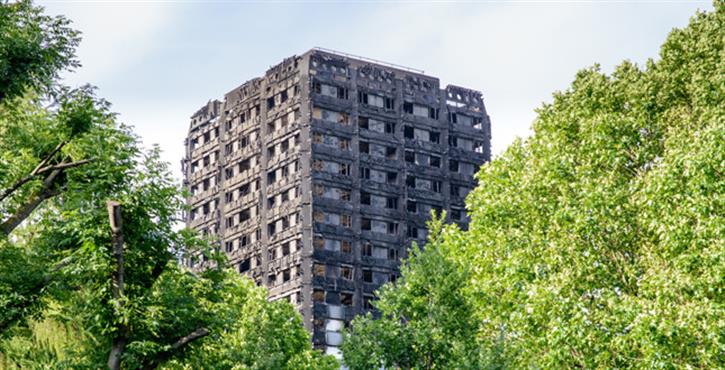

In the wake of the tragedy at Grenfell Tower, installers are being reminded of their fire safety obligations when laying pipes and ducting. Jennie Ward reports.
The fire that destroyed Grenfell Tower on 14 June, causing the deaths of 71 people, has prompted a full review of all Building Regulations, and in particular those concerning fire safety standards.
While much of the focus has been on fire safety in high-rise apartment blocks and commercial buildings, Graeme Dryden, Technical Services Manager of the Association of Plumbing & Heating Contractors (APHC), is warning installers that maintaining fire standards is equally important in a domestic setting.
The legislation that governs fire safety standards in England is Building Regulations Approved Document B, while Part J covers combustion appliances and fuel storage systems, and installers should be aware of both to ensure they adhere to the current standards. Both these documents apply to England, as Wales and Scotland have their own sets of Building Regulations.
“Installers need to consider fire safety and fire compartments wherever they are running pipes and services through the building fabric,” Graeme advised at a recent series of technical workshops run by the APHC.
He continued: “We tend to think that fire compartments and firestopping is something that we do in industrial and commercial applications, but it’s equally important in the domestic sector as well.”
Fire compartments
A fire compartment is a subsection of a building that has been divided up to restrict the spread of fire. This is done by constructing the compartment’s walls and floors of fire resistant material, to prevent any fire outbreak from spreading outside of the compartment in which it started and to give occupants time to leave the building.
Installers who work in tenanted properties or commercial buildings will be familiar with fire doors and other fire barriers, which are installed to form part of the structure of an individual compartment.
Fire compartments can also be found in apartment blocks and properties where the dwellings may be separate, but which share the same loft space, such as some terraced housing with a communal loft space.
In all these cases fire compartments are created, but it is vital that fire barriers are not compromised by the installation of any building services.
This doesn’t mean installers can’t run pipes through such walls and floors, but that when they do, the joints between the pipes and ducting must be fire stopped where they pass through, to ensure that there are no gaps. This must also be done for any ducting, conduits or cables that run between fire compartments, and also in connecting spaces such as stairways and service shafts.
Signs that a fire compartment could be present in a building are where a wall or ceiling separates shops from houses, a ceiling between a room and a building’s roof, and also where garages share internal walls with a property.
“In all these cases, installers should make sure you have an appropriate fire stop, and that may mean going back to the customer and explaining that you have to upgrade certain materials or carry out additional work to bring the building up to standard,” Graeme advised.
Fire stopping
Approved Document B defines a fire stop as “a seal provided to close an imperfection of fit or design tolerance between elements or components, to restrict the passage of fire and smoke”.
“Whenever we penetrate a fire barrier, we need to install a fire stop,” Graeme explained. “That could be soil pipework running through a slab where we have a block of flats.”
Fire dampers should be installed in HVAC ducts that penetrate fire-resistant constructions, and will automatically close on the detection of heat.
A wide range of fire stopping products are available for installers to use, including pipe collars, pipe wraps and fire resistant sealants.
Coated stone wool Batts are useful as fire stoppers for voids, while sealants and mastic coatings are suitable for all forms of fire-resistant construction, and are commonly used to seal small or unusually shaped gaps.
Cement mortar can also be used to form a fire-resistant, load bearing seal.
Intumescent collars and pipe wraps around soil waste pipes are perhaps the most common form of fire stop plumbers would come into contact with. These collars contain a compound that expands rapidly on exposure to fire, with the resultant pressure crushing the pipe and sealing the opening to prevent the spread of fire. Pipe wraps must be located within the separating structure, then backfilled with a fire-resistant mortar.
Building Regulations also allow pipes passing through a building fabric to be sleeved, but Graeme believes it is often cheaper and easier to buy a proprietary fitting.
Changing regulations
While it is far too early to know what changes will be made to English Building Regulations as a result of the fire at Grenfell Tower, one suggestion already being made is for fire suppression systems to become mandatory for newbuild properties, to bring England up to the same standards as Welsh Building Regulations, where they have been compulsory since 1 January, 2016.
“We will almost definitely see some form of regulation change in England,” Graeme said. “Around 200 civil servants have been drafted in to review fire safety, and I think we will see changes to enforcement as well, with an increase in self-regulation in Competent Person Schemes, and self-certification around fire safety.
He concluded: “Competence requirements will certainly be scrutinised, and it’s something that we all need to ask in the plumbing and heating industry, and the construction industry in general.”
If you'd like to keep up-to-date with the latest developments in the heating and plumbing industry, why not subscribe to our weekly newsletters? Just click the button below and you can ensure all the latest industry news and new product information lands in your inbox every week.